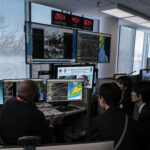The Arctic continues to deteriorate from global warming, not setting as many records this year as in the past, but still changing so rapidly that federal scientists call it alarming in their annual Arctic report card.
The 16th straight health check for the northern polar region spotlighted the first ever rainfall at Greenland summit station, record warm temperatures between October and December 2020, and the new problem of expansion of beavers in the Arctic.
“The trends are alarming and undeniable,” U.S. National Oceanic and Atmospheric Administration chief Rick Spinrad said in a prepared statement before presenting the findings by 111 scientists from 12 countries at the American Geophysical Union conference Tuesday.
The 2020-2021 polar year–scientists study the Arctic on a yearly basis from October to September–was only the 7th warmest on record. However, October to December in 2020 set a record for the warmest autumn.
This report card comes out as the Arctic warms two to three times faster than the rest of the planet. The region’s melting ice opens the door to more pressures, including the potential for more oil and gas drilling and more mining and more tensions between countries wanting to exploit the area. For the people who live there, it means having to adapt to a ground that is getting softer as permafrost melts and changes to traditional hunting and fishing.
When sea ice hit its annual minimum in September for how far it extends, it was only the 12th lowest on record. But the rarer thick sea ice, which stays around for more than a year, was the second lowest at the end of the summer since records began in 1985, reflecting a problem in the more crucial type of ice for the Arctic.
Report editor Twila Moon, a scientist at the National Snow and Ice Data Center, said people may think “if something is not setting a brand new record, then it’s going pretty well. And that is not true.”
The Arctic is on a roller coaster of acceptable conditions and horrible ones, Moon said, pointing to Greenland.
“If you had asked me in early July how we’re doing for the Greenland ice sheet, I would have given you two thumbs up. We were having, surprisingly, what felt like a normal year,” Moon said. “And then we had these really extreme melt events coming in late July and in August, creating brand new records, giving us rainfall observed at the summit of Greenland for the first time ever.”
It’s usually so cold there that precipitation always had fallen as snow.
Another weird situation was the expansion of beavers into the Arctic, something Moon called “stunning.”
Beavers are a problem because they dam an area causing more water to pool on the surface, which enhances permafrost thaw, making roads, airports, pipelines and structures less stable, Moon said.
“It’s a real transformation or disruption of the existing ecosystem,” Moon said.
Hours before the report card release, the World Meteorological Organization announced that it confirmed a new record warm temperature set for the Arctic in June 2020 in the Russian town of Verkhoyansk. Temperature in that Siberian town hit 100.4 degree s (38 degrees Celsius). That’s an absurd temperature for the Arctic, Moon said.
Was this article valuable?
Here are more articles you may enjoy.

 US Weather Service Merges Units as Staffing Pressure Rises
US Weather Service Merges Units as Staffing Pressure Rises  Family of Canadian CEO Killed in Helicopter Crash Files $35 Million Lawsuit
Family of Canadian CEO Killed in Helicopter Crash Files $35 Million Lawsuit  UK to Compel 1,000 Firms to Shore up Cyber Defenses After Hacks
UK to Compel 1,000 Firms to Shore up Cyber Defenses After Hacks  Bankrupt 23andMe’s DNA Data Gets Sale Nod as Concerns Linger
Bankrupt 23andMe’s DNA Data Gets Sale Nod as Concerns Linger 